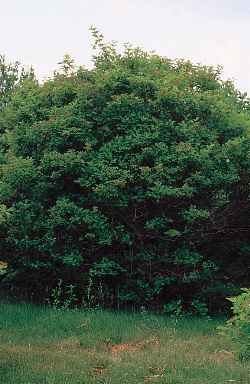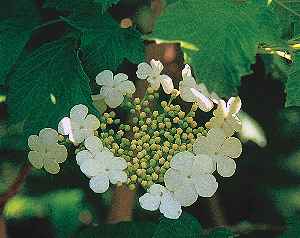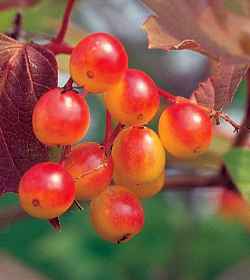American Cranberrybush
Scientific Name: Viburnum opulus var. americanum Ait.
Synonym: Viburnum opulus ssp. trilobum , Viburnum trilobum
Family: Caprifoliaceae

Viburnum opulus var. americanum, Herman, D.E. et al. 1996. North Dakota tree handbook. USDA NRCS ND State Soil Conservation Committee; NDSU Extension and Western Area Power Admin., Bismarck, ND.
Sunset®: 1-11,14-20
USDA: 3-9
Sun Exposure: Sun to part shade
Origin: Northern North America
Growth Habits: Deciduous, upright shrub, 10 to 15 feet tall and wide (3-4.5 m); gray bark, scaly with age; deep green leaves with 3 shallower lobes than V. opulus var. opulus, 2 to 4 inches long and wide (5-10 cm), lighter underside
Watering Needs: Regular water, prefers fertile soil, accommodating about the pH
Propagation: Cuttings, seeds

Viburnum opulus var. americanum, Herman, D.E. et al. 1996. North Dakota tree handbook. USDA NRCS ND State Soil Conservation Committee; NDSU Extension and Western Area Power Admin., Bismarck, ND.

Viburnum opulus var. americanum, Herman, D.E. et al. 1996. North Dakota tree handbook. USDA NRCS ND State Soil Conservation Committee; NDSU Extension and Western Area Power Admin., Bismarck, ND.
Blooming Habits:
White flowers in showy flat topped clusters, 2 to 4 inches in diameter (5-10 cm) in early summer. The larger flowers, 0.4 to 0.8 inches in diameter (1-2 cm), on the outside of the cluster are sterile. The smaller ones, 0.12 to 0.16 inch wide (3-4 mm) are the ones that will produce the seeds.
Fruiting Habits:
Showy orange to red drupes (with 1 seed), 0.3 to 0.4 inch in diameter (7-10 mm), in terminal clusters. They are acidic, edible and juicy, their flavor reminding of the cranberry. They ripen in the fall.
Desert-Tropicals is dedicated to provide gardening advice, gardening ideas, and information about flower of all kind for landscape and collections.We try to check carefully the identification of the plants on the illustrations as well as the other information from the page, but occasionally errors do occur. if you notice anything that needs to be changed please contact us.Thanks.
© 1998-2020 Philippe Faucon, All Rights Reserved.